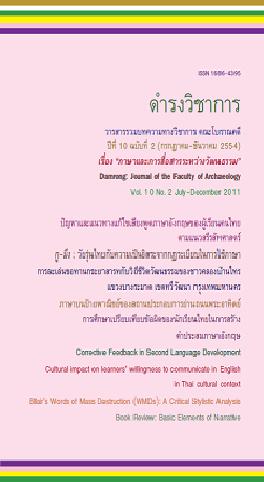CORRECTIVE FEEDBACK IN SECOND LANGUAGE DEVELOPMENT
Keywords:
-Abstract
This article reviews related intervention studies on the role of corrective feedback in second language learning. The intervention studies are divided into three main categories – classroom-based, laboratory-based, and computer-based studies – depending on the nature of the treatment settings. Research designs, results from the studies, as well as possible factors influencing the study outcomes are compared and discussed.
References
Ammar, A. & Spada, N. (2006). One size fits all? Recasts, prompts, and L2 learning.Studies in Second Language Acquisition, 28, 543-574.
Ayoun, D. (2001). The Role of Negative and Positive Feedback in the SecondLanguage Acquisition of the Passé Compose and Imparfait. The ModernLanguage Journal, 85, 226-243.
Carroll, S., & Swain, M. (1993). Explicit and implicit negative feedback: An empiricalstudy of the learning of linguistic generalization. Studies in SecondLanguage Acquisition, 15, 357-386.
DeKeyser, R. (1993). The effect of error correction on L2 grammar knowledge andoral proficiency. Modern Language Journal, 77, 501-514.
Doughty, C., & Varela, E. (1998). Communicative focus on form. In C. Doughty andJ. William (eds.) Focus on form in classroom second languageacquisition (pp. 114-138). Cambridge: Cambridge University Press.
Ellis, R. (2009). Corrective feedback and teacher development.L2 Journal, 1, 3-18.
Ellis, R., Loewen, S., & Erlam, R. (2006).Implicit and explicit corrective feedback andthe acquisition of L2 grammar.Studies in Second Language Acquisition,28, 339-368.
Fukuya, Y., & Zhang, Y. (2002). Effects of recasts on EFL learners’ acquisition of pragmalinguistic conventions of requests. Second Language Studies, 21.Retrieved November 2007 from http://www.hawaii.edu/sls/uhwpesl
House, J. (1996). Developing pragmatic fluency in English as a foreign language: Routines and metapragmatic awareness. Studies in Second LanguageAcquisition, 18, 225-252.
Koike, D.A., & Pearson, L. (2005). The effect of instruction and feedback in thedevelopment of pragmatic competence.System, 33, 481-501.
Krashen, S. (1985).The Input Hypothesis: Issues and implications. London: Longman.
Kubota, M. (1994). The role of Negative Feedback on the Acquisition of the EnglishDative Alternation by Japanese College Students of EFL. Institute forResearch in Language Teaching Bulletin, 8, 1-36.
Leeman, J. (2003). Recasts and second language development: Beyond negativeevidence. Studies in Second Language Acquisition, 25, 37-63.
Loewen, S., & Philp, J. (2006). Recasts in the adult English L2 classroom: Characteristics, explicitness, and effectiveness. Modern LanguageJournal, 90, 536-556.
Long, M., Inagaki, S., & Ortega, L. (1998). The role of implicit negative feedback inSLA: Models and recasts in Japanese and Spanish. Modern LanguageJournal, 82, 357-371.
Lyster, R., & Ranta, L. (1997). Corrective Feedback and Learner Uptake: Negotiationof Form in Communicative Classrooms. Studies in Second LanguageAcquisition, 19, 37-66.
Lyster, R. (1998a). Negotiation of Form, Recasts, and Explicit Correction in Relationto Error Types and Learner Repair in Immersion Classrooms.LanguageLearning, 48, 183-218.
Lyster, R. (1998b). Recasts, repetition, and ambiguity in L2 classroom discourse.Studies in Second Language Acquisition, 20, 55-85.
Lyster, R. (2002). Negotiation in Immersion Teacher-student Interaction.International Journal of Educational Research, 37, 237-253.
Lyster, R. (2004). Differential Effects of Prompts and Recasts in Form-Focused Instruction. Studies in Second Language Acquisition, 26, 399-432.
Lyster, R., & Mori, H. (2006). Interactional feedback and instructional counterbalance.Studies in Second Language Acquisition, 28, 269-300.
Mackey, A.,Gass, S., & McDonough, K. (2000). How Do Learners PerceiveInteractional Feedback? Studies in Second Language Acquisition, 22,471-97.
Mackey, A., & Philp, J. (1998). Conversational interaction and second language development: Recasts, responses, and red herrings? Modern Language Journal, 82, 338-356.
Martinez-Flor, A. (2004). The Effect of Instruction on the Development ofPragmatic Competence in the English as a Foreign Language Context:A Study Based on Suggestions. Doctoral Dissertation. Castello: Universitat Jaume I.
Muranoi, H. (2000). Focus on form through interaction enhancement: Integratingformal instruction into a communicative task in EFL classroom. LanguageLearning, 50, 617-673.
Nicholas, H., Lightbrown, P., & Spada, N. (2001). Recasts as feedback to languagelearners.Language Learning, 51, 719-758.
Panova, I. and Lyster, R. (2002). Patterns of corrective feedback and uptake in anadult ESL classroom.TESOL Quarterly, 36, 573-595.
Rose, K.R., & Ng Kwai-fun, C. (2001). Inductive and deductive teaching of compliments and compliment responses. In K.R. Rose and G. Kasper (eds.) Pragmatics in language teaching (pp. 200-222). Cambridge: Cambridge University Press.
Sanz, C., & Morgan-Short, K. (2004). Positive evidence vs. explicit rule presentationand explicit negative feedback: a computer-assisted study. LanguageLearning, 54, 35-78.
Schmidt, R. (1990). The role of consciousness in second language learning.AppliedLinguistics, 11, 17-46.
Sheen, Y. (2004). Corrective feedback and learner uptake in communicativeclassrooms across instructional settings.Language Teaching Research, 8,263-300.
Suzuki, M. (2003). Corrective Feedback and Learner Uptake in Adult ESLClassrooms.TESOL & Applied Linguistics, 4, 1-21.
Takahashi, S. (2001). The role of input enhancement in developing pragmaticcompetence. In K.R. Rose and G. Kasper (eds.) Pragmatics in languageteaching(pp. 171-199). Cambridge: Cambridge University Press.
Tateyama, Y. (2001). Explicit and implicit teaching of pragmatic routines. In K.R. Roseand G. Kasper (eds.) Pragmatics in language teaching (pp. 200-222).Cambridge: Cambridge University Press.
Washburn, G.N. (2001). Using situation comedies for pragmatic language teachingand learning. TESOL Journal, 10, 21-26.
Downloads
Issue
Section
License
บทความนี้เป็นผลงานของข้าพเจ้าแต่เพียงผู้เดียว และ/หรือเป็นผลงานของข้าพเจ้าและผู้ร่วมงาน ตามชื่อที่ระบุในบทความจริง และเป็นผลงานที่มิได้ถูกนำเสนอหรือตีพิมพ์ที่ใดมาก่อน





